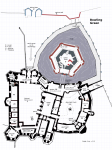squeen
8, 8, I forget what is for
My home campaign has taken a turn into uncharted waters (for me) and I'm looking for some advise.
BACKGROUND: The party has entered the King's palace, disguised as the heir-apparent (whom they had previously slain while he was mixing it up with them incognito as a reoccurring villain of their pedestrian nightmares)---a former Moriarty to their Holmes. They know something is off with the King, but they need to convince him to raise the army to stop a strategic invasion of a borderland outpost of which they are particularly fond. They party has gotten up to 7th-ish level, and I'm trying to introduce some domain play (via Domains at War, which I recently purchased based on Two Orc's recommendation---and which majorly impressed me enough to pay for a ginormous 4'x4' hexmap on mouse-pad foam for the miniatures/tokens). The siege by a 1000-soldier army convinced the party not to tackle this single-handed.
I've (mostly) mapped and keyed the palace inside the city. Made a list of the major players in the court (King, Stewart, Head of the Palace Guards/Secret Police, younger brother of the dead prince, king's new and irritating 'royal advisor', visiting vassals, household head of staff, general of the army, etc.), but am looking for a good example of this kind of play environment, or just some general tips of how to handle it.
I've thought about purchasing Masque of the Worms with the hope that it covers a similar situation of social intrigue, but am looking for other sources.
Thanks in advance.
BACKGROUND: The party has entered the King's palace, disguised as the heir-apparent (whom they had previously slain while he was mixing it up with them incognito as a reoccurring villain of their pedestrian nightmares)---a former Moriarty to their Holmes. They know something is off with the King, but they need to convince him to raise the army to stop a strategic invasion of a borderland outpost of which they are particularly fond. They party has gotten up to 7th-ish level, and I'm trying to introduce some domain play (via Domains at War, which I recently purchased based on Two Orc's recommendation---and which majorly impressed me enough to pay for a ginormous 4'x4' hexmap on mouse-pad foam for the miniatures/tokens). The siege by a 1000-soldier army convinced the party not to tackle this single-handed.
I've (mostly) mapped and keyed the palace inside the city. Made a list of the major players in the court (King, Stewart, Head of the Palace Guards/Secret Police, younger brother of the dead prince, king's new and irritating 'royal advisor', visiting vassals, household head of staff, general of the army, etc.), but am looking for a good example of this kind of play environment, or just some general tips of how to handle it.
I've thought about purchasing Masque of the Worms with the hope that it covers a similar situation of social intrigue, but am looking for other sources.
Thanks in advance.
